Finders—keepers 😉 Want to keep all CLM knowledge handy?
Leave your email to get this guide as a PDF
What is Contract Lifecycle Management: A-Z Guide
Contract lifecycle management (CLM) software simplifies contract management processes through automation. It aims to help centralize contract storage, improve compliance, and automate any contractual agreement’s creation, execution, and management.
As a result, contract management software boosts contract process efficiency while removing unnecessary bureaucracy. Standardizing templates, language, and rules allows all parties to save time and eliminate errors.
Contract management software is designed to boost contract process efficiency and cut down on unnecessary bureaucratic expenses.
CLM software provides:
- Time management for each contract management stage
- Automated workload allocation
- Documentation and records tracking for audits and compliance checks
- Alignment with contract management rules and processes
- Transparent performance measurements
Ultimately, a successful CLM software frees up time and resources that can be used for higher-value work.
That’s the goal of CLM software in a nutshell. However, much more is needed to truly understand contract lifecycle management. Our A-Z guide on CLM will take you through many of the nuts and bolts you should know.
Table of Contents
Chapter 1
CLM and Customer Relationship Management
Table of Contents
- CLM and Customer Relationship Management
- CLM Goals
- CLM Market 2022–2027
- CLM Software
- CLM Stages
- Do I Need a CLM System?
- How CLM Systems Can Improve CLM Processes
- Industries that can benefit from CLM software
- Non-Legal departments that can benefit from CLM
- Outsourcing vs Insourcing CLM Processes
- ROI of Contract Management Software
- Risks Mitigated by CLM Software
- Top 8 Features to Look for in a CLM Solution
- Transforming CLM from Software to Partner
- What You Should Know: CLM Best Practices
- What You Should Know: CLM Case Studies
- Wrapping Up
An increasing number of companies are integrating contract management with their customer relationship management (CRM) systems. This makes sense since CRM’s primary objective is to make it convenient for clients to do business with the company — and as it turns out, CLM systems are built with that exact purpose in mind.
Сontract management software spares customers from having to deal with tedious exchanges or manually adjusting, signing, and faxing documents. As a result, the company creates a better brand image and shows it cares about its clients and partners. This added convenience can prove to be the deciding factor for clients who are considering other competitors.
By integrating contract management into your CRM system, you can automatically track and identify existing opportunities. CLM software helps foster continuous innovation throughout the company, and it can assist in setting new industry standards.
Moreover, the degree of process digitization serves as proof that the business is growing, and that future innovation and scalability are essential for the company. After all, companies in a poor situation don’t innovate.
Overall, CLM software promotes an inclusive mindset for the company, its clients, and its partners, putting your business at the forefront of innovation.
Chapter 2
CLM Goals
Companies face numerous risks when working with vendors. In this respect, efficient contract lifecycle management systems can make a real difference in risk management.
The contract signing process is quite lengthy and has many variables. Without an established procedure in place, it’s easy to slip up.
The goal of CLM is to address the following pain points:
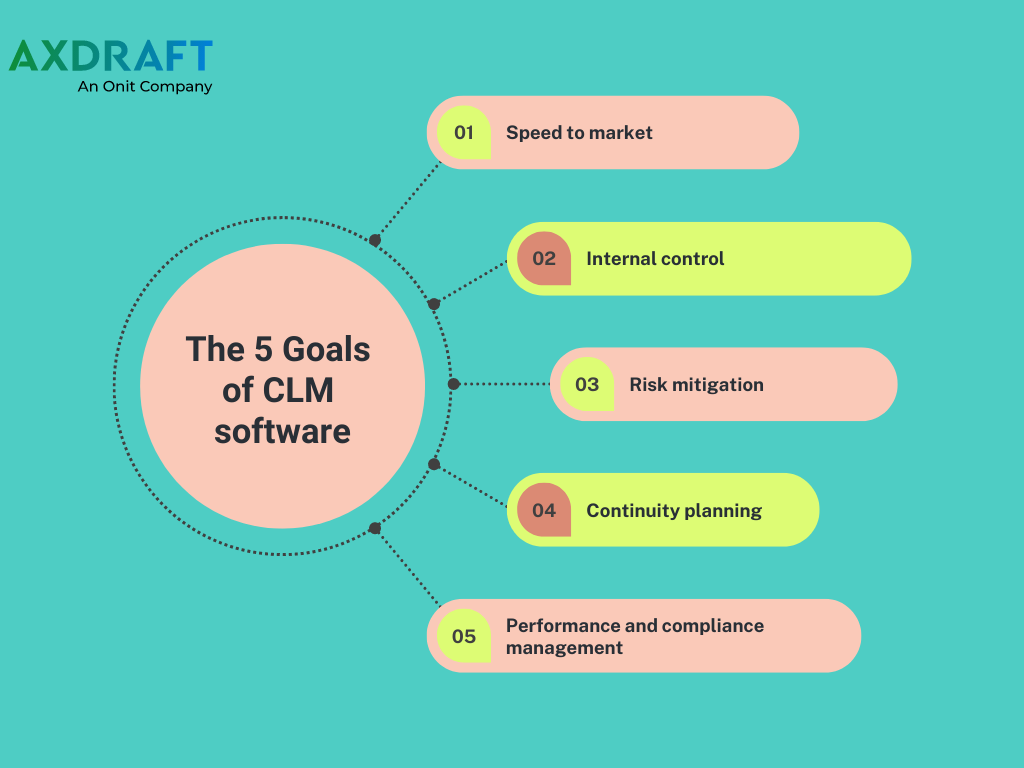
Speed to market
Intense market competition forces companies to support innovation and deliver timely results. One of the best ways to operate efficiently is to establish straightforward contract authoring, negotiation, and execution processes.
As your business grows, this will help lead to new vendor relationships and a greater focus on customer experience. All in all, this approach will lead to increased income since you won’t be spending time and money on unnecessary bureaucracy.
Internal control
Contracts should reflect your company’s best interests. By setting up CLM processes, you ensure that you’ll have up-to-date, relevant information from stakeholders at each stage. At the same time, you guarantee that you’ll be internally addressing pertinent subject matters.
Risk mitigation
Risk mitigation is the primary focus of all pre-contract execution stages. The main goal of contract request, authoring, negotiation, and approval is to ensure that all parties benefit from the agreement while reducing the risk of potential losses.
Performance and compliance management
A thorough CLM process and controlled step-by-step execution represent an investment in effective and productive vendor relationships. Addressing regulatory compliance requirements in your contracts ensures that vendor partnerships meet your standards.
Continuity planning
A successful contract lifecycle management process supports continuity planning with your business partners. By incorporating renewal and termination language into your agreements, your company obtains the leverage required to hold vendors accountable while giving you the opportunity to renew or terminate agreements based on your current market situation.
Legal departments are responsible for building an efficient CLM process that positively affects the company’s overall operation quality. Fortunately, these days, legal departments can swiftly complete the majority of monotonous tasks while eliminating human error with automation software.
Chapter 3
CLM Market 2022–2027
The global market size for CLM software reached $1.70 billion in 2021, and it’s expected to hit $3.30 billion by 2027. For 2022–2027, this represents an annual growth rate of 11.4% (compounded). Demand is particularly high in the manufacturing, healthcare, public, and financial service sectors.
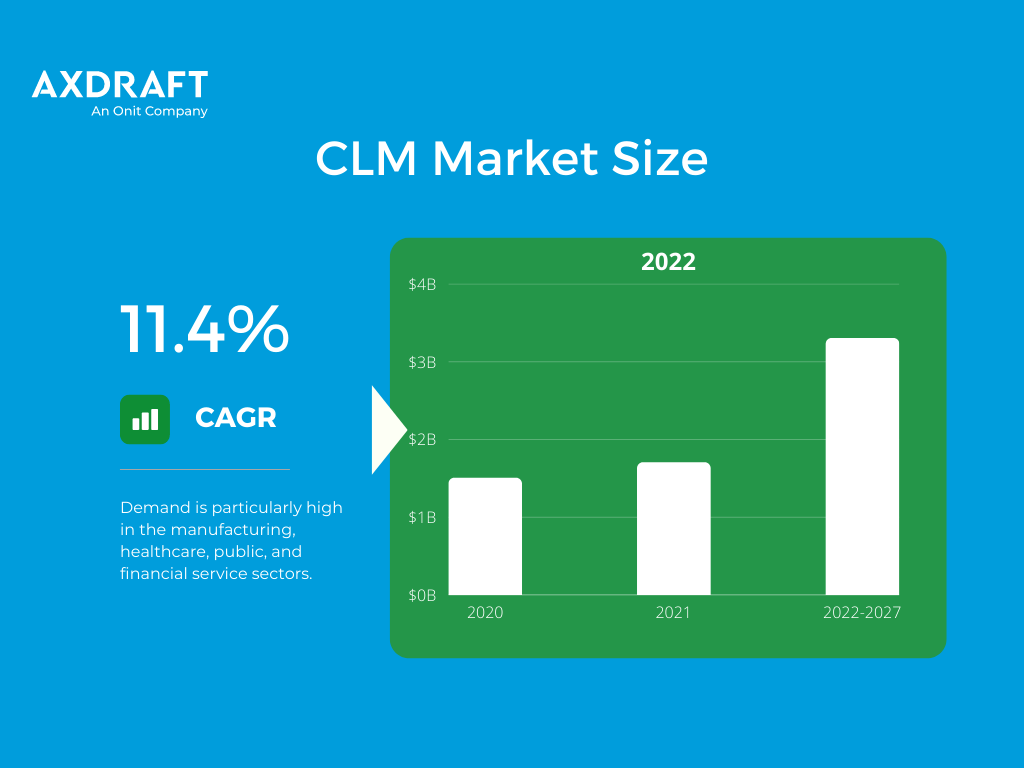
The global CLM software market also extends into retail and e-commerce, pharmaceuticals, manufacturing, electronics, automotive, banking, financial services, and insurance (BFSI). Of these, manufacturing presently dominates the market.
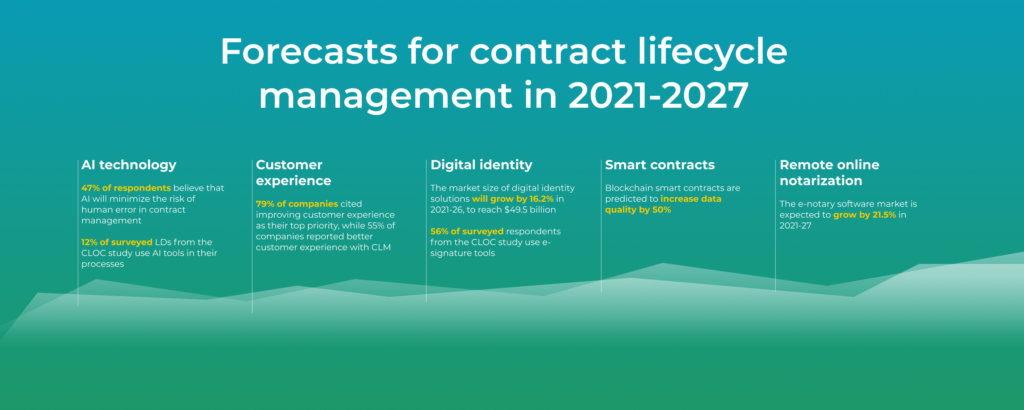
Instead of weakening the CLM industry, the COVID-19 pandemic only bolstered the demand for CLM systems that facilitate partnerships between firms. Rapid globalization has rendered collaboration particularly critical, which is why it’s no surprise that cloud-based software has topped the demand for on-premise software.

Chapter 4
CLM Software
There are a lot of different components that make up contract lifecycle management software. Not only can it use the latest technology, but it can integrate with several other systems.
Artificial intelligence in contract lifecycle management
AI-based CLM software enables smart contract authoring to use machine learning (ML) algorithms for identifying patterns and learning from past contracts. Legal teams no longer have to manually extract terms and clauses from contracts. AI-enabled CLM systems employ natural language processing (NLP), optical character recognition, and text analytics to digitize legacy contracts and transform them into workable documents.
The CLM market’s incredible growth has bolstered the rise of contract management technology. Firms can no longer get by on a first-generation CLM. To become a powerhouse of operational excellence, you need a contract management solution that leverages artificial intelligence.
Firms can even extract information from contracts quickly and auto-tag documents with company names, deadlines, and renewal alerts. They can also use AI-enabled solutions to parse through documents, identify sub-optimal terms, and suggest alternative clauses that mitigate risks and safeguard interests. Advanced analytics provide actionable insights that let organizations achieve the best value for their negotiations.
Types of CLM software
CLM software can be classified as one of four different types:
On-premise deployment lets you install contract management software on your company’s servers. This allows you to manage CLM system updates, security, and maintenance without involving a third party. A major tradeoff is that you’ll have to invest heavily in database software, hard drive space, and additional power.
Hosted by a third-party company, cloud-based CLM software lets you enjoy all the tools you need without having to actively manage any server. It saves you from the hefty expenses on hardware and licenses. With all data available via the cloud, your team can enjoy easy access to tools and documents anytime, anywhere.
Enterprise CLM software automates contract management processes throughout the organization, from sales and procurement to legal and HR. It allows you to seamlessly manage all of the company’s commitments on one platform.
Some companies integrate CLM modules into their existing enterprise resource planning (ERP) software. Contract management is folded into the system they use to manage day-to-day business processes like project management, accounting, and supply chain operations.
CLM and associated software
CLM systems are able to work alongside other software that’s meant to make business processes much more efficient.
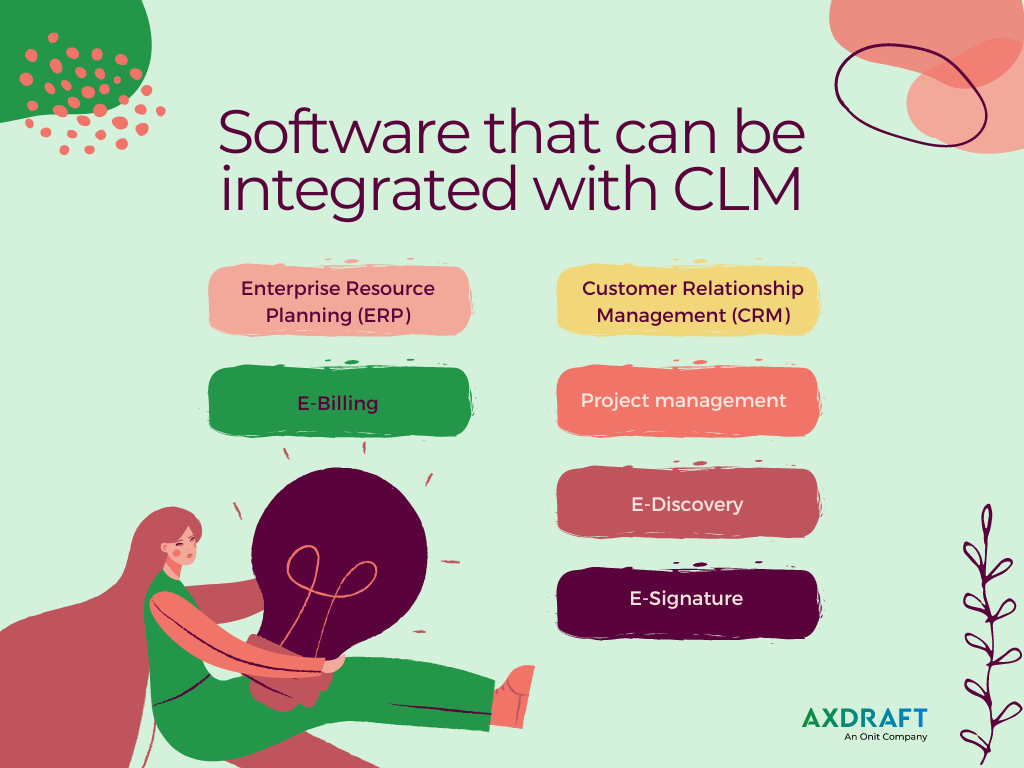
Enterprise resource planning (ERP)
ERP software integrates all processes needed to run a company—sales, procurement, accounting, marketing, legal, and human resources—into a single system. It functions as a central database, provides real-time reporting, and facilitates communication between business units.
An ERP system is able to ease business processes by integrating a contract management module. This module can then easily fill in contract templates with information from its database.
CRM software compiles customer data and points of contact. It then provides sales professionals with the information they need to foster meaningful and fruitful relationships with clients. On top of that, it lets them track, forecast, and manage sales leads and opportunities.
Customer relationship management (CRM)
By linking your CLM system with CRM applications, you can shorten these sales cycles. The integrated experience allows sales representatives to request contracts without having to key in customer data or get bogged down in back-and-forth exchanges with contract managers.
Project management
Project management software equips project managers and stakeholders with tools to more efficiently (and effectively) plan projects, allocate resources, and set schedules. It breaks complex processes into manageable parts while empowering PMs to guide projects from start to finish.
Integrating contract management software with project controls allows stakeholders to easily evaluate contract performance, track cost overruns, monitor unmet deadlines, collect and analyze contract bids, and award contracts.
E-billing
An alternative to paper billing, electronic billing (e-billing) allows companies and individuals to send and pay bills in machine-readable data formats electronically via web portals or emails. By integrating e-billing into your CLM system, you can manage your vendors and obligations better.
E-discovery
Digital investigations usually involve a large amount of data. This makes file storage and exchange particularly challenging.
CLM systems provide a repository that guarantees secure data storage and easy collaboration. As a result, they excel at supporting e-discovery.
E-discovery refers to the digital investigation or search for evidence of electronic files. Such files include instant messages, emails, digital images, online documents, social profiles, and website content.
E-signature
With teams and stakeholders spread out over multiple locations, signing contracts with pen and paper has become outdated and largely inefficient. CLM systems include e-signature features that allow users to sign documents anywhere, so long as they have an Internet connection. Consequently, organizations can now execute agreements much faster.
E-signatures also leave audit trails that allow you to track, monitor, and check whether signed documents are valid. They even assist with contract renewals, as a CLM system’s automated features are capable of initiating renewal processes and collecting signatures.
Chapter 5
CLM Stages
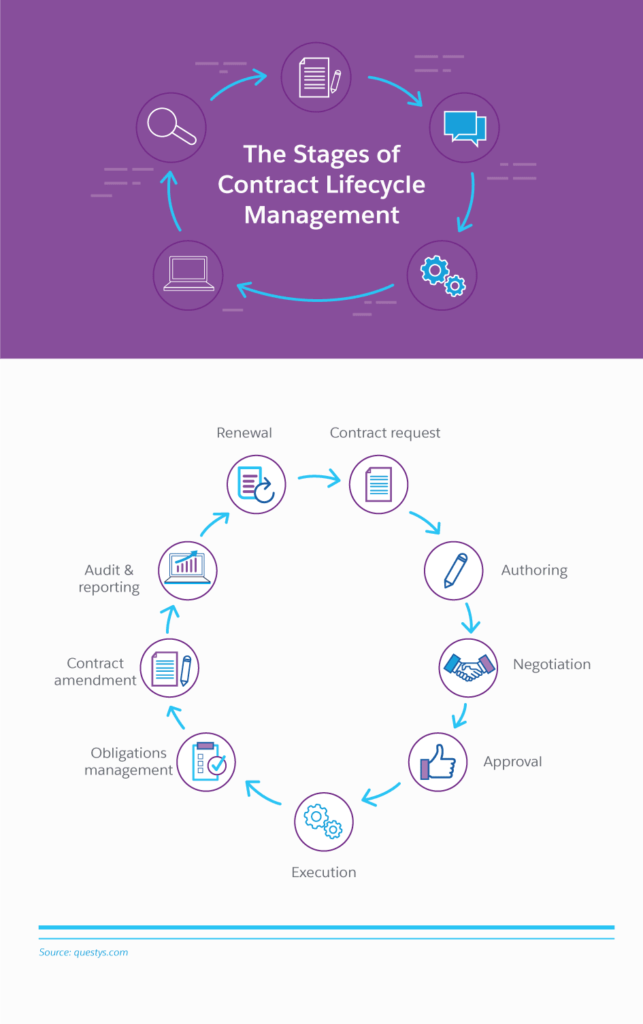
When it comes to adopting CLM software, it is important to understand the flow of the contract lifecycle management process. CLM ensures that a contract’s complicated journey is understandable, compartmentalized, and in the organization’s best interests.
These steps outlined below are the basic CLM stages that businesses should follow when executing an agreement. Some stages may take longer than others due to many human and technical factors. It’s also possible that a company may adapt this process to suit their needs.
The initial stage of contract lifecycle management, this occurs when one party initiates or requests that the contracting process start. Any information received is then used to draft and author the contract.
Also known as the drafting stage, this is when all details and conditions are defined in the agreement.
After the contract is drafted, all parties sit at the bargaining table to negotiate the terms and conditions. All sides then review the contract to make sure everyone is satisfied.
Depending on the contract, internal or external third-party legal approval (or both) may be needed. The approved version is passed to a specialist for review.
After the contract is approved, it is manually or digitally signed by all parties.
Once the contract is signed, the promises made by both sides need to be fulfilled. In other words, each party needs to do what they said they would.
There are various practices for tracking contractual obligations. However, this is typically up to the organization to decide what works best for them.
If some aspect of the contract must be changed, all parties must go through a new round of drafting, negotiation, approval, and so on. This is fairly typical, especially for long-term, multi-year deals.
Companies should provide regular reports to all stakeholders regarding an agreement’s execution and performance. At the same time, companies must ensure that specific contracts are in compliance with industry requirements and government regulations.
This step is essential as it represents a new stage of cooperation for all parties involved. Thoughtful and on-time contract renewals can benefit everyone, while ignoring the deadline can result in lawsuits or other negative consequences.
Chapter 6
Do I Need a CLM System?
Regardless of size and industry, businesses run on contracts. This is especially true if you’re navigating a myriad of relationships involving partners, clients, and vendors.
But even if you aren’t managing complex agreements, your legal team may be forced to handle contract management processes that keep them bogged down in routine work.
You may understand that there’s a lot to gain from implementing a CLM system. But should you forge ahead and adopt the tech? And if you do, how can you avoid becoming the next cautionary tale of a failed digital transformation?
In order to successfully adopt CLM software, you should reflect on your organization’s readiness to embrace it. To get started, you can assess your current CLM processes. This CLM maturity survey may prove useful in guiding your reflection.

Chapter 7
How CLM Systems Can Improve CLM Processes
CLM software ensures that contract lifecycle management processes flow efficiently and productively in the following areas:
Authoring

A template library can significantly accelerate contract turnaround. It also mitigates some risks by increasing standardization and language uniformity.
Moreover, smart template authoring simplifies the drafting process for users. This is because it inserts pre-approved clauses into the document, supports text customization, creates metadata tags, and adds necessary exhibits and annexures. Before authorizing a ready-to-use template, it has to be approved by the legal department.
Creation
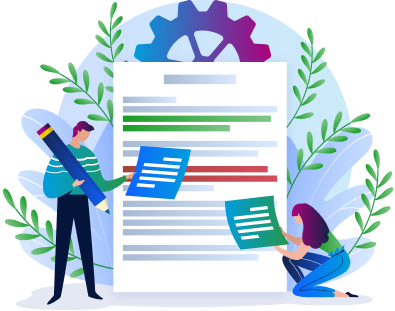
CLM software automatically compiles necessary content according to established contract criteria. By default, this includes location, products, services, and pricing. In addition to greater control over contracting operations, rules-based authoring improves an agreement’s scalability.
Advanced CLM software often permits no-touch contract creation by using the company’s CRM data to construct an agreement according to company rules. This self-service contract creation model allows organizations to significantly reduce legal operation expenses. As a result, the larger number of contracts in less time can significantly boost revenue.
Review

CLM software workflows are often naturally compliant with the contract lifecycle management process. For example, before sending a contract to financial systems for execution, the software will assign the document to a legal employee for review.
As it proceeds step-by-step through the workflow, it complies with the requirements of each contract lifecycle stage.
Approval
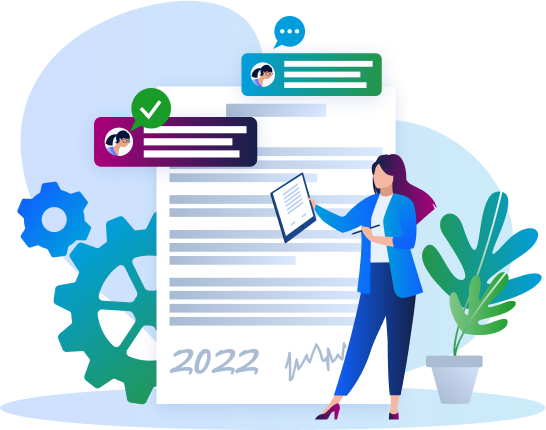
The contract approval process requires a thorough analysis of associated data. The best contract lifecycle management software will facilitate the approval process, even when it comes to sequential and/or parallel approvals. The system’s workflows can easily be adjusted to accommodate any negotiation updates in the contracts.
For companies that don’t use CLM software, users are typically in charge of manually updating workflows according to the newest requirements.
Execution

Modern CLM software usually features various integrations with online signature services like Adobe Sign. Such integrations help automate the signing process and ensure seamless document updates without needing human intervention.
Signature software should also support manually signing documents, as some parties may be unfamiliar with online systems. This type of software often comes equipped with QR-code technology to help validate manually signed documents.
Performance
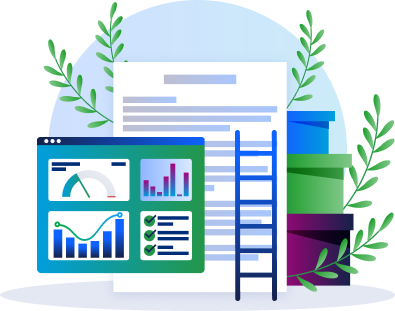
After execution, contract administration can also be improved by CLM software. CLM systems provide analytics regarding contract performance cycle times, deviations, company savings, potential risks, agreement expirations, and renewals.
CLM software also offers valuable procurement and sales data on contract revenue and expenses. Additionally, CLM software can take care of task completion management by identifying tasks, assigning them to users, and tracking their completion.
Expiration

Contract lifecycle management systems notify users about major milestones and contract expiration dates. On top of that, if needed, it can automate and simplify the renewal process.
CLM software is designed to improve every step of the contract lifecycle management process. It will assume a significant portion of your legal department’s workload, freeing them for higher-value work.
For instance, if your lawyer has to physically send contracts to vendors after every edit, imagine how much time and money you could save if the entire process was digital. Instead of drawing up a new vendor contract each time, your legal employee can create several universal drafts that can be customized as needed.
Back to topChapter 8
Industries that can benefit from CLM software
No matter what industry you’re operating in, you stand to benefit from a CLM system.
The legal department is responsible and accountable for the overall contract lifecycle. Since CLM software automates and standardizes processes, legal teams can work more efficiently and error-free. Lawyers can start focusing on strategic thinking and high-value work that require their expertise.
Healthcare organizations operate in a highly regulated industry where any violations can lead to stiff penalties. CLM software helps ensure healthcare organizations strictly adhere to compliance requirements.
The finance team scrutinizes each agreement to determine its tax implications, profits, and losses. They also monitor billing, payroll, and assets.
Financial experts must keep records to communicate the state of the company’s finances to stakeholders. Equipped with metadata, reporting, and record-keeping tools, CLM software can make their work more efficient and reliable.
Since CLM software makes the e-signing and delivery of legal documents fast and easy, HR personnel no longer have to spend significant amounts of time on this back-and-forth. They can also complete employment agreements and NDAs quicker.
Pharmaceutical companies work on research and development projects that handle sensitive data. They also distribute medication.
As a result, their operations are burdened with record-keeping and administrative tasks. Equipped with a secure file repository, CLM software can help streamline their processes.
Manufacturing companies deal with multiple suppliers from various industries and countries. They also manage business relationships that have to be set in stone by ironclad agreements.
CLM software ensures that all contracts are legally valid and binding. This allows manufacturing companies to rest assured that their suppliers and partners will hold up their end of the bargain.
Chapter 9
Non-Legal departments that can benefit from CLM
CLM software combines various contract-related tasks onto one platform so that your legal team can easily synchronize processes with other business units. This greatly reduces the endless back-and-forth between departments.
Centralized platforms help discourage other business units from adopting processes that don’t align with how the legal team manages contracts. This allows legal to focus on substance instead of process, saving time on correcting documents or requesting information.
Now that hybrid work environments have become the new norm, CLM systems are critical. Having a cloud-based platform facilitates collaboration between on-site and remote staff. It also aids in fast-tracking approval processes and sending out automated notifications, ensuring every company unit is doing its part.
In today’s business world, contract management is no longer limited to just the legal team. Some business teams even process more agreements than the legal department.
If you’re wondering how non-legal departments can benefit from a CLM system, here are some examples.
Sales

CLM systems help speed up the rate at which the sales department finalizes service agreements, supply contracts, work contracts, and sales agreements. The software automatically fills out documents using information from databases and clauses from the clause library. Once complete, the documents are sent to relevant parties for approval and e-signing.
Not only will software increase the speed at which contracts are completed and deals are closed, your sales team can benefit from increased collaboration, business growth, and minimized revenue loss.
Human resources

Frequently, HR doesn’t send contracts to the legal department for review. They rely on templates that are usually exchanged between their team and new hires to complete agreements. Equipped with dynamic templates and a clause library, CLM software can streamline the workflow for HR teams.
The HR department can also use the software to onboard new hires, pull up employee data, and analyze performance. They can even leverage it to control costs, keep payroll transparent, and manage risks.
CLM systems are particularly helpful for completing employment agreements, NDAs, contractor agreements and invoices, and various claims and orders.
Marketing

Your colleagues from the marketing department are up to their neck in marketing strategies, campaigns, and events. Fortunately, they deal with standardized contracts that don’t require legal review. All the same, they need to be certain they’re using templates that are compliant. CLM software can automate their processes while ensuring every agreement is valid.
A CLM system helps ensure that agreements are protecting the company’s interests and holding contractors accountable. It also keeps the marketing team informed of due dates and contract deliverables, notifying them when it’s time to terminate (or renew) contracts.
CLM software can greatly shorten the time it takes to complete advertising contracts, GDPR documents, NDAs, invoices, and service agreements with influencers, contractors, or agencies.
Finance

CLM systems highlight key contract information like amounts and payment methods as metadata, making data simpler to find, manage, and use. This then results in a faster approval process.
CLM software also improves financial performance tracking by making contract values readily viewable. With most processes automated, the financial team can ensure compliance and meet deadlines.
Those responsible for budgeting and financial forecasts will find value in a CLM system that’s integrated with their ERP. That’s because CLM systems can be used for invoices, loan documents, and merchant agreements. All documents are stored in a single repository where they can be easily grouped and classified, facilitating reports and analysis.
Procurement

The procurement department can rely on CLM systems to speed up the completion of supply agreements, service agreements, and contract claims to logistics vendors. Thanks to automated processes, the team can count on faster procurement cycles, quicker approval flows, and minimized delays. They also benefit from greater visibility into deliverables and due dates.
Notifications prompt the procurement department to revisit and re-negotiate contract terms and conditions. The team may end up spotting better deals, convincing them to terminate subpar or unnecessary contracts.
Business development

The business development team needs CLM software to quickly close deals. Integration with third-party ERP and CRM systems further speeds up the process.
Since CLM software allows the easy transfer of data between documents, supplementary documents can be provided quickly.
Public-facing templates can be made available for the onboarding of new partners and clients. Multilingual documents allow your business to operate globally. The system can even be integrated with public registers.
The business development department handles contracts that can be standardized and don’t require legal review. The list includes lease agreements, tender documents, NDAs, sublease agreements, and property transfer acts.
Information Technology

Privacy is the primary concern for the IT department. CLM software with security features like cloud deployment and SOC-2 certification can help ensure just that.
A top-notch CLM system can automate the management of security-related documents to the point of self-service. This allows you to collect filled and signed contracts without needing to interact with other parties.
Improved on-platform collaboration, greater accessibility, faster client/supplier onboarding, granular access controls, and a secure contract repository all factor into a system that ensures performance without compromising privacy.
CLM software helps IT departments complete NDAs, DPAs, SOC-2 report requests, work orders, IP documents, and service agreements.
Back to topChapter 10
Outsourcing vs Insourcing CLM Processes
Not long ago, it was the norm for firms to outsource their time-consuming and resource-intensive contract management processes. But as pressure to meet compliance standards and ensure data security ramped up, more and more enterprises have developed their in-house capacity for managing contracts.
Here’s a breakdown of the pros and cons of outsourcing versus insourcing contract management.
Outsourcing CLM processes
Outsourcing is quite the rave these days, but will it work for your contract management processes?
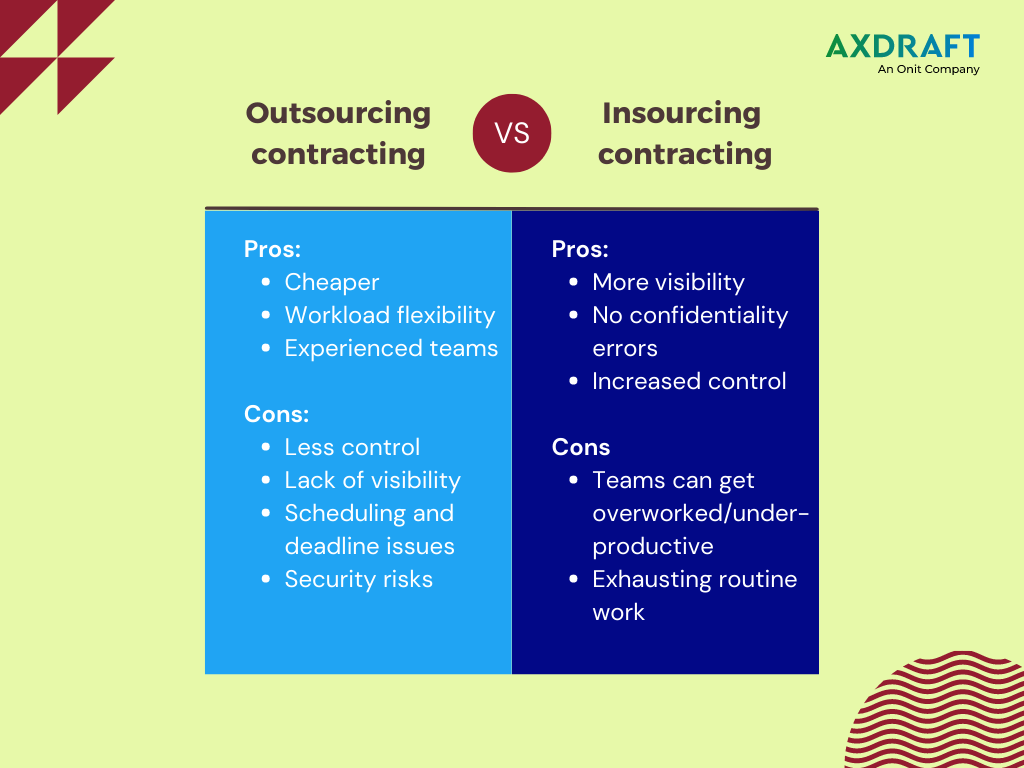
Pros
- Outsourcing contract management to specialists allows you to leverage their operational cost efficiency. You’ll end up paying a fraction of the cost that you’d typically pay an internal legal team.
- An outsourced team can adjust to your varying workloads, allowing you to scale as necessary.
- Outsourced specialists have the experience and expertise to ensure data accuracy.
Cons
- You may feel like you’re not in full control of the process if you have to depend on external partners.
- You have to put up with a lack of visibility.
- Scheduling and deadline management can pose a problem if you’re dealing with an outsourced team that’s handling other clients at the same time.
- Sharing confidential data with a third party poses security risks.
Insourcing CLM processes
For some, outsourcing is the way to go, but for others, they’d rather stick with in-house. So will an in-house contract management team work for you?
Pros
- With greater visibility into the CLM process, your internal team will be in a good position to spot potential profits and savings opportunities. They are loyal to your company, and thus more likely to pore over details, find mistakes, and identify weaknesses in agreements.
- Confidential data won’t be shared with a third party, so the risk of a data breach is lessened.
- You have greater control over your own team’s schedule as you’ll be working with people focused solely on your business.
Cons
- Depending on your workload at any given time, your team may shift between being overworked or underproductive.
- Your top-notch legal experts may be swamped with routine work.
Bear in mind that keeping contract management in-house does not necessitate overburdening your legal team with grunt work. Armed with the right CLM software, lawyers can still maintain the bandwidth for work that requires their expertise and strategic thinking.
Gone are the times when firms had to wait two to three years to fully establish a streamlined internal contract management team. You don’t even have to increase your headcount to shift your CLM in-house. Your legal team can rely on CLM tools to automate processes and complete time-consuming routine work.
Chapter 11
ROI of Contract Management Software
CLM software fast-tracks the contract lifecycle so that you’ll be in a better position to catch opportunities and meet deadlines. Access to data-driven insights accelerates time-to-agreement, cutting the time your team spends on negotiating. And given that time is money, investing in software will boost your revenue.
Even though the legal department and other teams benefit greatly from CLM software, old habits die hard, and some employees might resist the change. Here are some general rules for determining the return on investment when adopting contract management software. You should consider:
Supplier compliance
CLM software allows organizations to cut expenses by providing data that helps ensure suppliers comply with agreements.
Internal compliance
Contract lifecycle management systems help prevent errors and legal mistakes by using templates and unifying data.
Better sourcing
CLM reports can make negotiations more effective. By gathering and analyzing existing data, the legal department can make smarter decisions about contract terminations or renewals.
Workflow efficiency
Contract management software can enhance productivity by automating processes, gathering and analyzing data, and decreasing the time needed to create contracts.
Calculating ROI
To maximize the return on your CLM software, you should calculate potential savings in each area and establish an ROI based on the analysis’s outcome. Once the contract management software is implemented, the system will supply the necessary data to continuously monitor your ROI.
Chapter 12
Risks Mitigated by CLM Software
Failing to stay on top of your contract management processes exposes your company to risks that can result in major crises.
By losing track of your contractual process, you can lose money. Missing a contract deadline might result in lost business, or a rollover clause may extend a contract beyond your intended duration.
Data breaches can incur major financial losses and reputational damage to your organization. By storing contracts in high-risk locations or transmitting them in unsafe ways, you could be exposing your company to security risks. For example, the mere act of emailing documents increases your exposure.
Legal risks associated with regulatory issues and party disputes are imminent when you fail to meet compliance requirements and contractual obligations. You could also find your company in hot water if you fail to use the right legal clauses and confidentiality disclosures.
Failing to keep up with your contractual obligations will not only earn you unhappy customers and disgruntled employees, it can also result in reputational damage that hurts your brand. Bad news spreads ultra-fast in today’s digital world, so make sure you’re keeping up with your commitments.
CLM systems mitigate these risks by increasing your control over the contract lifecycle. You’ll be able to monitor agreements, track edits, and ensure proper review and approval. CLMs also ensure you’re keeping up with regulatory changes, resulting in max compliance.
Chapter 13
Top 8 Features to Look for in a CLM Solution
Here are the basics you should look for when searching for a contract lifecycle management solution.
Workflow management
Straightforward workflows ensure all contract lifecycle management stages are being followed, enabling you to track agreements through each pre- and post-execution phase.
Cloud storage
A contract lifecycle management service should use centralized storage for all documents to avoid mix-ups like creating multiple versions of the same document or confusing contract lifecycle stages.
Security
Look for systems that allow customizable security roles. It’s much safer to build security around your organizational structure and restrict users based on their responsibility for specific contracts.
Dynamic template editor
An easy way to create templates is very important for risk mitigation. Templates simplify data collection, which helps eliminate major mistakes.
Collaboration
Highly-functional contract lifecycle management systems must streamline the negotiation and review process. When it comes to a system’s features, it should offer extensive tracking and sharing capabilities, automated communication and collaboration features like comments and chats, and the ability to share documents inside and outside the system.
Search
Once documents are stored in a single cloud database, you need to make sure you can quickly and easily find them. Systems that offer document scanning and indexing, in addition to basic file name searches, are especially helpful.
Analytics and reporting
By automating the contract signing process, you receive a more reliable source of valuable data, which is crucial for business decisions. CLM analytics and reporting may prove to be your best advisor when deciding whether to extend or terminate a particular partnership.
Notifications
Notifications give you instant updates on processes. Since you’re adopting contract management software to streamline and optimize the contract signing process, it’s essential to make sure you’re always on top of what’s going on.
Chapter 14
Transforming CLM from Software to Partner
Don’t just work with a software vendor—connect with a partner. It all starts with choosing the right software provider.
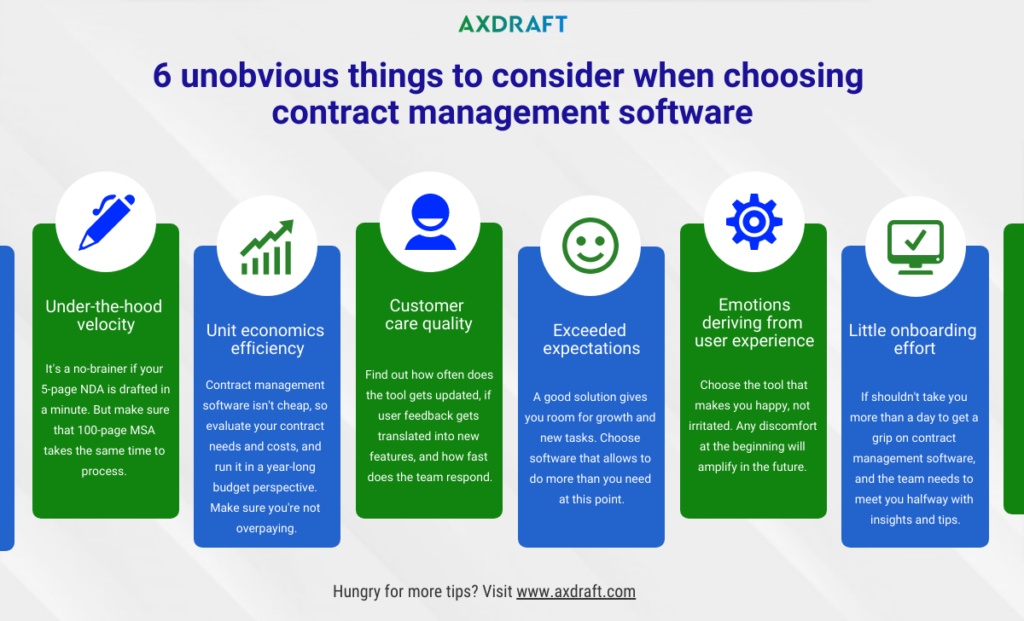
Steer clear of CLM vendors who offer plug-and-play solutions. You know you’re dealing with a partner if the software provider goes out of their way to create a mission-critical solution or adjust their product to make it better for your case.
A partner always takes the time to figure out your unique needs. To ensure success, they also work with you even after the purchase is complete. They’re ready to go above and beyond in accommodating and addressing your growing needs. You can count on them to treat your processes and workflows with as much care and dedication as they do their own.
Software partners are there for every step of the way to make sure the system is helping your firm thrive. They provide excellent after-sales service and customer support. They also work ceaselessly on innovations to future-proof your system.
It pays off to do your homework before purchasing a solution. Don’t just check the software features—dig deep into the company’s culture to see if they’re the right fit for you.
Last but not least, software partners should be geared to weather the test of time. It’s not uncommon for software companies to fail, stranding customers with a defunct system. So try to choose a well-established provider who can maintain a lasting partnership. Transitioning to a new system is costly and time-consuming, so make sure to get this right.
Chapter 15
What You Should Know: CLM Best Practices
Contracts lay the foundation for your business relationships, which is why managing them effectively is critical. Here are some guidelines to help you out.
Organize contracts in a central repository

Storing files in multiple locations, folders, and spreadsheets makes it hard to access, track, and secure your data. Keeping all your contracts in a single repository allows you to stay organized. You can pull up a particular document in an instant, search for specific clauses and terms, and view agreements by category. More importantly, you can track who’s accessing files and prevent data leakages.
Set automated alerts
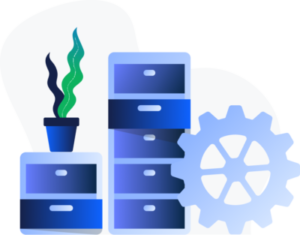
Missing deadlines and failing to keep up with contractual obligations can cost you dearly. Imagine getting locked into another year of obligations simply because you missed the agreement’s termination schedule. Setting automated alerts can help you avoid such situations. A CLM system sets notifications for contract milestones and sends them to the individuals who are responsible.
Prepare a library of approved clauses and templates
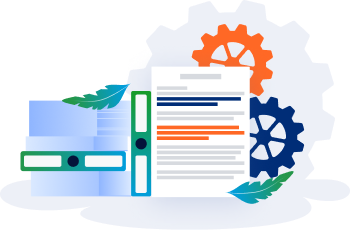
Legal teams tend to spend more time than necessary drafting contracts when they are unsure of the clauses they’re using. You can make your team more productive and contract-compliant by compiling legal-approved clauses and templates. It will also standardize formats, reducing the need for manual corrections and time-consuming back-and-forths.
Stay on top of version control
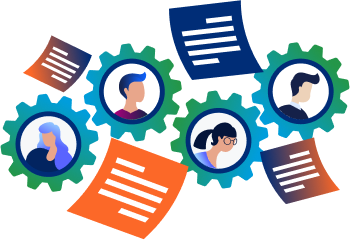
It’s hard to track a document’s changes when multiple people are editing it. There’s also the risk of duplicating tasks.
CLM systems track changes and ensure everyone’s working only on the latest version. No user will be making the same adjustments that someone else did before. Version control guarantees that when you finalize a contract, it’s in its final form and with 100% accurate data.
Create well-defined and documented workflows

Prepare clearly defined workflows that mirror your company’s rules and processes. You can then minimize manual tasks and automate workflows for smooth contract processes.
Your legal team won’t have to spend too much time monitoring and facilitating all contract lifecycle stages. You’ll free up the team’s bandwidth for more meaningful work while preventing tasks and minute details from falling through the cracks.
Simplify and standardize the contract request process
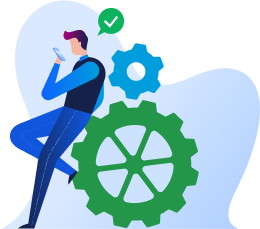
Manually requesting contracts and information might result in errors and unnecessary delays. By digitizing the contract request process, you can standardize data collection and make it easy for people to gather all necessary details. The legal team won’t have to swamp people with emails or make repeated phone calls.
Fast-track the approval process
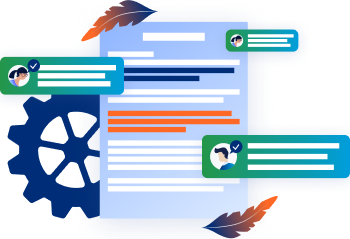
Approval is often one of the slowest parts of the contract lifecycle.
CLM systems help you speed it up by automating notifications and enabling e-signatures. The software can also send alerts when the contract is ready for approval. Data is even encrypted so that stakeholders are able to access documents from anywhere in the world without worrying about security breaches.
On top of that, you can propel the process forward by setting up automated workflows that replicate your business processes and automatically prompt relevant individuals to act. Chasing down colleagues and business partners has become a thing of the past.
A fully adjustable scenario that accounts for multiple variables within a single workflow can significantly improve your system’s efficiency.
Boost security with granular access controls

Make sure everyone in your organization has access only to files and contract processes that are relevant to their role.
For greater security, your CLM system should allow you to limit access to highly confidential documents. Setting feature-based and role-based permissions will help you avoid security breaches and careless errors. For instance, a “read-only” user access prevents people from making unintended edits to contracts.
Measure success and improve performance with real-time insights

CLM systems provide analytics and reports via a user-friendly dashboard. Use the data to track your team’s productivity and pinpoint areas of improvement. Reports deliver actionable insights that you can use to make better decisions and lift your team’s performance to the next level. Track your KPIs, establish benchmarks, and set goals for future improvements.
Keep an audit trail

Audit trails are needed to comply with regulatory standards like PCI and HIPAA. When copies of files and documents are stored in different locations, it is difficult to catalog past activities and transactions. A centralized repository provides the automated features you need to create complete and reliable audit trails. And with just a few clicks, you can extract a contract’s entire history.
Back to topChapter 16
What You Should Know: CLM Case Studies
Want a glimpse of how CLM software works in the real world? Here are two examples: Modna Kasta and EPAP.
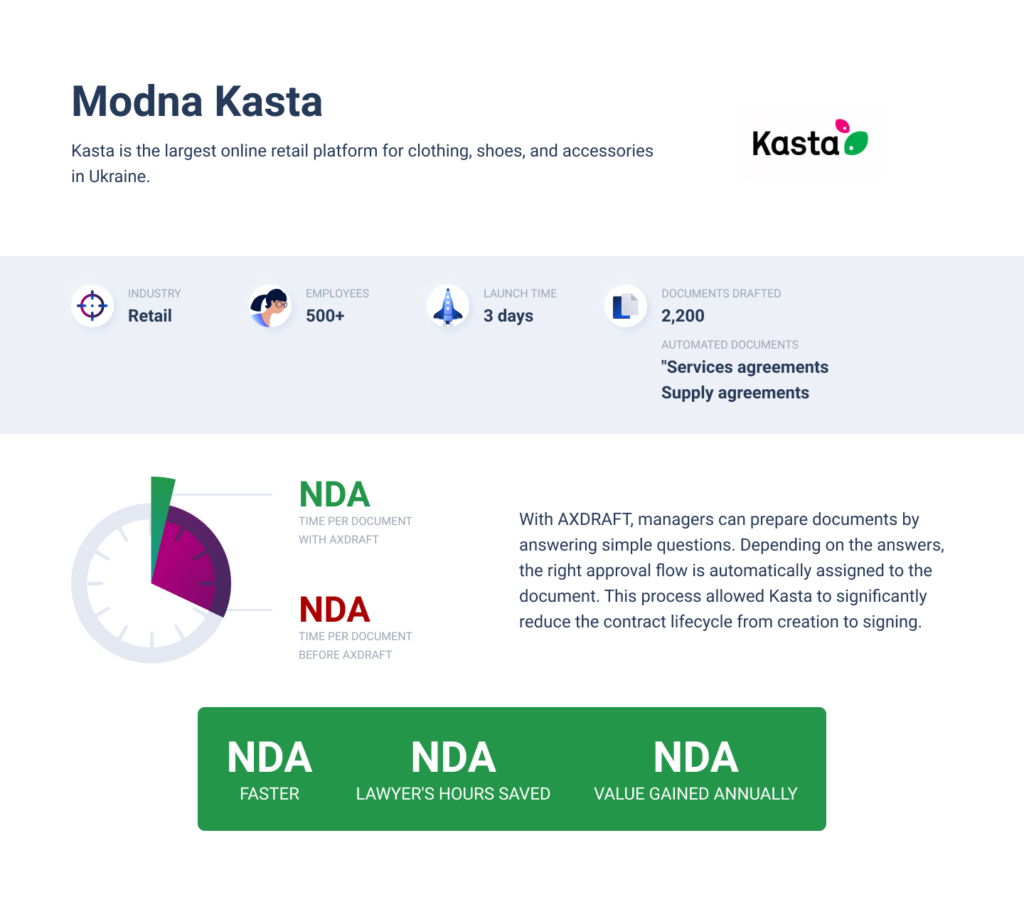
A leading online shopping platform for fashion and lifestyle products, Modna Kasta relies on CLM software to lighten its load in managing service agreements and supplier contracts. Managers need only answer simple questions for the CLM system to get its gears rolling and automatically assign the appropriate document approval flow. This cuts the time it takes for a contract to go from creation to signing.
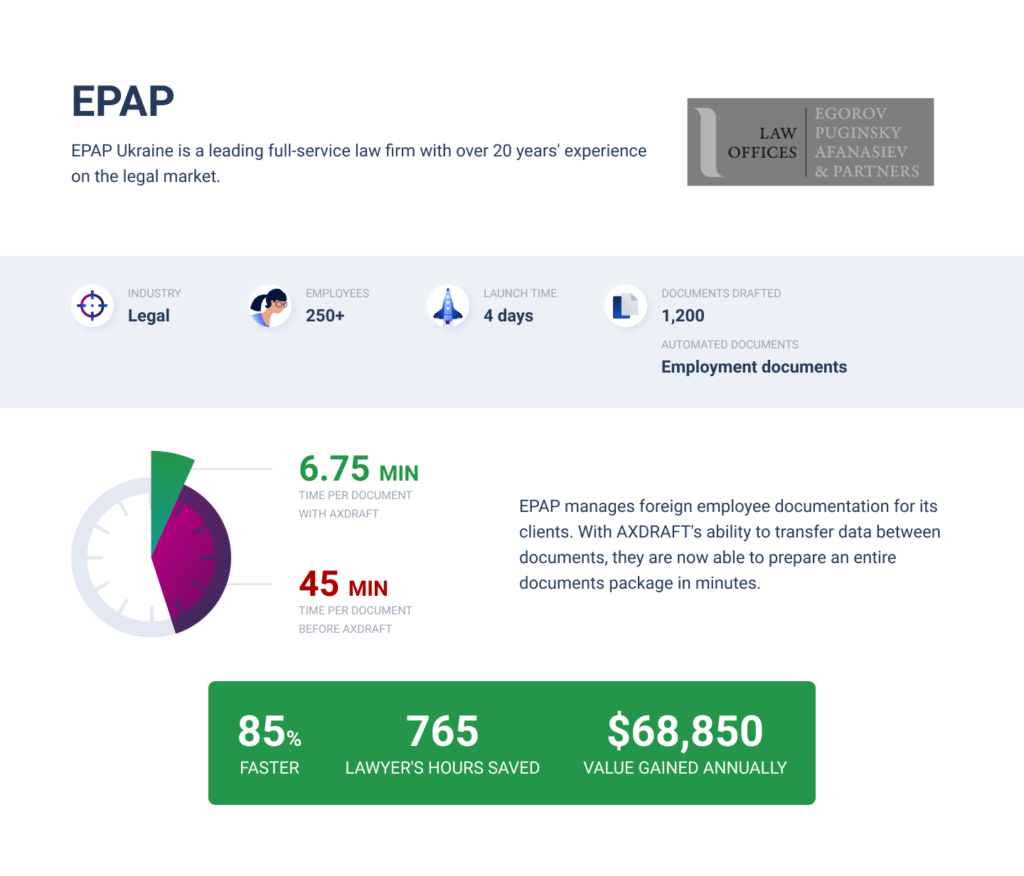
A leading full-service law firm with 20 years of experience under its belt, EPAP handles foreign employee documentation for its clients. CLM software speeds up data transfer between documents so that the firm can finalize an entire document package in a matter of minutes. Their process is now 85% faster, amounting to $68,850 worth of value gained annually.
Wrapping Up
After reviewing the general concept of contract lifecycle management software and its benefits, we created a shortlist of questions to ask yourself when choosing one:
- Does the system offer cloud storage?
- Can you customize contract data based on user needs?
- Does the system provide correct notifications?
- Can you search for a document based on information in the document? Can you search for a document by name?
- Does the system provide extensive analytics and reporting?
- Can the provider customize the CLM system according to your needs and specific requests?
Are there other questions you have regarding contract management automation? We would be glad to help you!
Assess your current processes first. Chances are that your legal team spends more time managing contracts than doing high-value work. Your sales reps may have missed out on opportunities or experienced some stalled business deals. Perhaps your company was fined after failing to comply with its contractual obligations.
The right CLM solution will help you capitalize on opportunities, close deals faster, avoid legal liabilities, and minimize risks. The cost and time savings, as well as the revenue generated, will more than make up for the software investment.
A contract lifecycle management system streamlines and automates contract processes, allowing legal and business teams to proactively and effectively manage all lifecycle stages—initiation, authoring, negotiation, approval, execution, and renewal or termination.
Both an administrative and strategic tool, a CLM system will help your company fully enjoy the benefits of every contract. At the same time, analytics and reporting features will improve your legal team’s overall performance.
Regulatory bodies, business partners, vendors, and customers expect organizations to meet their contractual obligations. Failure to do so can result in reputational damage and legal liability. CLM helps you stay organized from beginning to end, as well as remain compliant with all regulations and obligations.
Contracts set the foundation for your relationships with suppliers and service providers. To keep your procurement lifecycle running smoothly, you need to manage your contract processes properly. The right CLM software can help reduce supplier costs, forecast expenses, terminate unfavorable deals, improve external relationships, speed up negotiations, and execute agreements efficiently.